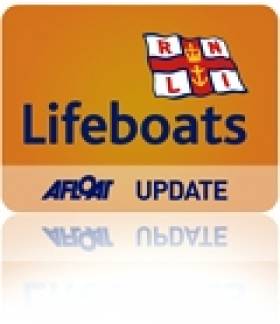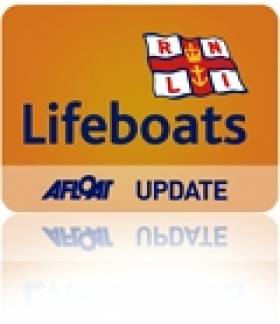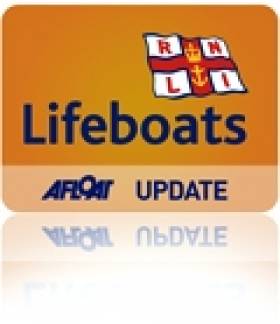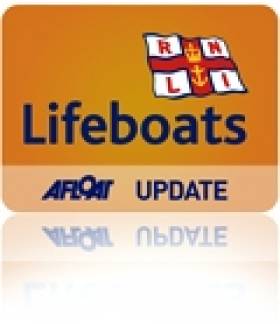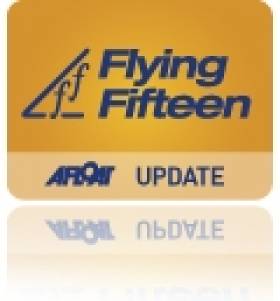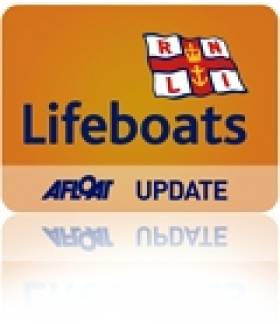Displaying items by tag: Red Bay
Red Bay Lifeboat Rescues Three From Drifting Speedboat
#RNLI - Red Bay RNLI has rescued three men yesterday afternoon (Sunday 1 November) after they got into difficulty on a 4m speedboat which was drifting out to sea off the North Coast.
The volunteer lifeboat crew was alerted by Belfast Coastguard just before noon and requested to go the aid of three people on a broken down vessel which was lost somewhere off Cushendun.
One of the casualties had managed to raise the alarm with a relative using his mobile phone.
The inshore lifeboat, helmed by Kevin Allen and with crew members Stephen Conway, James McLaughlin and Owen McKinley onboard, launched within minutes and made its way to towards Cushendun.
Despite an extensive search on scene the lifeboat crew could not locate any vessel in distress in the specific search area.
The lifeboat crew widened their search and requested the assistance of the Sligo-based Irish Coast Guard helicopter Rescue 118.
After searching for two-and-a-half hours in what were described as difficult weather conditions, the lifeboat crew finally located the vessel some four miles off Garron Point at Red Bay. The boat was drifting out in blustery sea squall conditions.
The three men, who were not in immediate danger but suffering from shock, were taken onboard the lifeboat and brought safely back to Red Bay where they were made comfortable.
Speaking following the callout, Red Bay RNLI volunteer lifeboat press officer Paddy McLaughlin said: "These three men were extremely lucky this afternoon as their small vessel had broken down and was rapidly drifting out to sea.
The callout was particularly challenging for the lifeboat crew as the casualties were unsure of where they were lost and it took a considerable amount of time to find them.
"Our crew is highly trained and using their navigation skills particularly, they were able to locate the casualties, all of whom were relieved to see the lifeboat, and bring them safely back to shore this afternoon."
McLaughlin added: "We would remind anyone taking to the water to carry a means of communication and plan your trip in advance so you are familiar with the area should you get into any difficulty and need to request assistance."
#rnli – The RNLI has today announced that following a review of lifeboat cover in Northern Ireland, an additional all weather lifeboat will be put on service on the North Antrim Coast. This lifeboat will be based in Cushendall for a 24 month trial and will operate alongside the current inshore lifeboat at Red Bay RNLI.
The decision was made following the RNLI's Trustees agreement with the Operations Committee's in-depth review of lifeboat cover in the area. The RNLI carries out a five yearly review of all lifeboat stations, including the incidents its lifeboats launch to and the changing pattern of marine activities, to ensure existing and future lifeboat coverage is correct for the area.
The current Red Bay RNLI inshore lifeboat is operating in a place well known for strong tidal streams and rough sea conditions with the nearest all weather lifeboat stations based at Portrush (30 miles), Larne (17 miles) and Campbeltown (32 miles). All weather lifeboats can be operated safely in all conditions while inshore lifeboats usually operate closer to shore and cliffs, in shallower water and among rocks or caves. The RNLI felt that the provision of an extra all weather lifeboat in this area would meet the charity's 'concept of operations' on the North Coast.
The volunteer lifeboat crew at Red Bay RNLI have launched on 33 occasions in wind speeds of Force 5 or higher between 2008 and 2013, which resulted in 27 rescues and five people being saved. The addition of an all weather lifeboat in this location will ensure even greater coverage on the North Antrim Coast.
A lifeboat station was established in Cushendall on the Antrim coast between Larne and Ballycastle in 1972. Since then Red Bay RNLI volunteer lifeboat crews have launched 516 times, brought 489 people to safety and saved 114 lives. Last year alone, Red Bay RNLI launched 22 times bringing 36 people to safety. Of those launches, six services were carried out in the hours of darkness.
Responding to the announcement, Paddy McLaughlin from Red Bay RNLI said: 'We are delighted that the RNLI have decided to trial an all weather lifeboat on the north coast, to be operated alongside our Atlantic 85 lifeboat. Our volunteer lifeboat crew can face some challenging conditions, which are sometimes on the margin of the capabilities of an inshore lifeboat. The provision of an additional all weather lifeboat on the north Antrim coast means our lifeboat crew can launch in all conditions, day or night, up to 100 miles off our coastline.'
Darren Byers, RNLI Divisional Operations Manager added: 'Our charity's priority is to save lives at sea and by conducting regular reviews of lifeboat cover around our coastline, we can ensure we provide the best possible search and rescue service.
'The co-location of the new lifeboat for a trial period of 24 months will allow us to assess the long-term value for this type of lifeboat while ensuring that the RNLI has the right type, balance and capability of lifeboats on the coast, to respond to all types of maritime emergencies.'
The timescale for the arrival of the all-weather lifeboat has yet to be confirmed but will coincide with the training of the volunteer lifeboat crew to meet the demands of their new vessel.
Red Bay Lifeboat Launches To Aid Lone Yachtsman In Poor Weather
#RNLI - Red Bay RNLI's lifeboat crew went to the aid of a lone yachtsman some 1.5 miles off Glenarm in Co Antrim yesterday evening (Sunday 29 March).
The volunteer lifeboat crew launched at 6.10pm to assist the 25-foot yacht, which was requiring assistance due to adverse weather conditions and strong winds.
- One member of the lifeboat crew was placed on board the vessel to assist the yachtsman.
The boat was towed to Glenarm Marina by the lifeboat crew. No one was injured in the incident.
Red Bay RNLI Lifeboat Crew Rescue Walkers on Fair Head
#redbayrnli – Lifeboat crew with Red Bay RNLI launched this afternoon to go to the aid of three walkers who got into difficulty on the Boulder Field at Fair Head, County Antrim. The two men and one teenager raised the alarmed when they became disorientated and were unable to make their way to safety. Red Bay RNLI lifeboat crew were launched at 5.05pm and made their way through strong tides to help the three stranded people to safety.
The small group managed to make their way to the base of the cliff where they waited for help. Two of the volunteer crew swam from the lifeboat to the base of the cliff and escorted the three people to safety. The lifeboat crew had taken spare survival suits with them on the callout, which they gave to the three people as they made their way from the cliff out to the lifeboat. The specially made suits are watertight and have a special insulation layer to keep the wearer warm in freezing water. The group were cold but otherwise suffered no injuries. They were brought by lifeboat to Ballycastle.
Commenting on the callout Red Bay RNLI helm Paddy McLaughlin said, 'With the hours of daylight increasing, more people are spending time outdoors and undertaking activities on or near the water. Fair Head is a beautiful part of the coastline and is very popular with walkers and hikers but we would urge caution.
We receive a large number of callouts to this location each year from people who injure themselves or get into difficulty on the cliff. Always make sure you know where you are going and that you wear and bring the correct equipment with you. It is also very important that you bring a means of communication in case you get into difficulty.
Missing Woman Sparks Red Bay & Portrush RNLI Lifeboat Search
#rnli – Red Bay and Portrush RNLI lifeboat launched in challenging conditions this morning to aid in search for missing woman on the North Coast of Ireland.
In freezing conditions both Red Bay and Portrush RNLI lifeboat crews launched to take part in an intensive search for a missing woman in her thirties. The two lifeboats carried out a search in freezing winds and heavy swells to try and local the missing woman. The lifeboats were launched at 9.20am and joined both the PSNI and local coastguard in a huge agency search.
The lifeboat crews concentrated their search in the Ballycastle and North Antrim coast area. After three hours the woman was located inland by the PSNI and the search was stood down.
Commenting on the Sunday morning callout Red Bay RNLI helm Paddy McLaughlin said 'Conditions were challenging this morning and we are relieved that the missing woman has been found safe.
We would advise people to always tell another person where they are going and that if they are concerned for someone's welfare to make contact with the emergency services. Please also take care around the coastline as the recent weather makes conditions unpredictable.'
Red Bay Lifeboat Rescues Lone Sailor
#RNLI - The volunteer lifeboat crew with Red Bay RNLI in Co Antrim were paged on Friday evening (12 September) at 6.55pm to a lone sailor on a 22ft yacht who got into difficulty in strong tides off the North Antrim coast.
The sailor had left Portrush for Bangor at 7am that morning and requested assistance from Belfast Coastguard later in the day after he was unable to make any headway in the seas.
The lifeboat had difficulty locating the vessel due to fog and the fact that the tides had pushed the boat some four miles off course south of Rathlin Island.
However, once located, the yacht was towed by the Red Bay lifeboat crew to Cushendall, arriving at 9.45pm.
Red Bay RNLI spokesman Paddy McLaughlin commented: "Tonight's call out was made more difficult due to the strong tides and fog but we were able to locate the sailor using our onboard VHF direction-finding equipment and radar."
The volunteer lifeboat crew from Cushendall have been kept busy over the past few months answering a large number of emergency calls off the North Antrim coast.
#flyingfifteen – National Flying Fifteen champions Ian Mathews and Keith Poole of Dun Laoghaire could not match Roger Chamberlain and Charley Horder for Northern Championship honours at Cushendall Sailing Club today. The Strangford Lough pair moved up a gear from the last meet at Carlingford a month ago to win the 20–boat championships by four points. Results sheet available to download below.
While other east coast sailing events were becalmed the Fifteens enjoyed a good sailing breeze off the Antrim coast at Red Bay even if Saturday's winds were shifty.
Three windward leeward courses were sailed on Saturday in the lighter winds but today saw triangle courses in up to 20 knots of breeze.
Third overall in the keelboat class was another Northern Ireland based Flying fifteen, Stifflers Mom, sailed by Brian McKee and John Gibson of Portaferry.
There was applause for the excellent race management at Cushendall and also for the shoreside marshalling and local hospitality.
Full class report below:
What a weekend that was in Cushendall at the foot of the amazing Glens of Antrim. With wind and sunshine you would be forgiven for thinking we were on the continent. Twenty boats took part in The Flying Fifteen Northern Championships in the picturesque village of Cushendall at the weekend hosted by Cushendall Sailing Club. The welcome and hospitality were great and very appreciated by those who traveled. Roger Chamberlain & Charlie Horder (SLSC) won the event comfortably on the score board withr some very consistent results and could even afford to retire from the last race. Ian Mathews & Keith Poole (NYC) were second with McKee & Gibson (SLSC) third.
Saturday morning there was a light breeze, more than enough for racing but it was to be shifty in a challenging tide.
Race1: the fleet got away at first time of asking, on the beat the fleet split tacks but those on the left came in to the weather mark first, Niall & Nikki Meagher sailing Ffantastically Mr Fox(NYC) lead the way followed closely by Green/Mulligan in Frequent Flyer. Downwind they increased their lead, on the second beat the Meaghers stayed out as Green went left closer to the shore. As they tacked for the weather mark there was a drop in pressure and a major shift, the two lead boats had their spinaker's up before the mark, unfortuently for the Meaghers Green got inside as did many others who went in towards the shore. On the final run with the course shortened as the wind dropped the whole fleet bunched up but Green held on to take the gun beating over the line followed very closely by Chamberlain, McCleery, Marcus Creighton and Mulvin who all drifted towards the line faster.
Race 2: the fleet set off in shifty conditions. Midway through the race the breeze was battling with a sea breeze, the tide was strong running south towards Belfast but it was supposed to be going out! Chamberlain was going well with McCleary and Mathews going wel, also having another good race was Marcus Creighton (SSC)and Joe Coughlin (NYC) The PRO again shortened the course and the top positions didn't change, even on the last beat place were lost and gained with the shifts.
Race 3: we thought the wind had settled to a sea breeze but there were a couple of shifts shortly after the start, there was also a strong tide especially out on the right. On the beat most boats headed towards the shore, after a few short tack Gorman/Doorly (NYC) got to the weather mark first just ahead of Mulvin and Chamberlain with Mathews and McCleary close behind. The wind remained steady, on lap two Chamberlain got inside Mulvin to take second place, Mulvin sailing extremely well kept the pressure on Chamberlain but remained in third place at the finish. All three laps were completed, the first full race of the day!
Once ashore the club put on great entertainment and food, after the refreshments some crews headed up to Giants Causeway for a bit of culture others into JJ's pub also for a bit of culture. Sunday morning greeted us with beautiful sunshine and a nice breeze from the NW, perfect conditions for racing. The tide was coming in most of the morning but even though it is open sea the tide does turn well before the high water.
Race 4: the fleet got going at the second time of asking, the pin end was favoured and the majority of boats headed inshore, some including McKee went right. McKee arrived at the weather mark first just ahead of Gorman and Mathews. Today we had a triangle and the reaches were exciting. McKee held on to take the gun with Mathews second and Chamberlain third crossing the line with Gorman. Chamberlain was now in pole position to win the event.
Race 5: again the pin was favoured and most boats headed for the shore, there was an individual recall and McCleary and Chamberlain had to go back. McKee again went right. It clearly paid as he came to the weather mark followed very closely by Mathews, Gorman and Murphy. Downwind Malcom Crighton and Tom Murphy went left and went into second and third place. The next beat was again shifty with different wind strengths up the course Murphy was sailing really well and moved into second place. On the reaches some places changed but Mc Kee held on to win with Murphy second and Mathews third
The silver, bronze and classic fleet were close affairs and all the results can be seen on website www.flyingfifteen.ie. For our second regional championships, the competition in the fleet was as keen as ever with very close racing. Even though Roger and Charlie won with a race to spare the racing was incredibly close with boats crossing the line together on the water.
Roger Chamberlain thanked the club Commodore for an enjoyable event, the sponsors, the PRO and his team, his fellow competitors and even his crew Charlie who then went on to thank everybody again! A special word of thanks from from Roger in his capacity of FFAI President was for those who prepared the fantastic food and for the shore team that helped get us on and off the water. Those who didn't travel missed an enjoyable event in a fantastic setting. The next event is the Championships of Ireland which will be held in Portaferry in August.
Red Bay Lifeboat Involved In Rescue Of Man Overboard
#RNLI - Red Bay RNLI was involved in the rescue Sunday afternoon (4 May) of a man who fell overboard from a boat near Cushendall in Co Antrim.
The man had fallen from the vessel near Waterfoot pier and was in the water for nearly 30 minutes. Members of the public raised the alarm.
A local fish farm boat located the man in the water and he was then moved to the lifeboat, where he was treated for hypothermia before been transferred to a waiting ambulance crew.
His condition is thought not to be life-threatening.
#RNLI - Red Bay RNLI's lifeboat launched on service early on Easter Sunday morning to go to the aid of a support boat with two people on board near Glenarm, Co Antrim.
The boat had suffered engine failure and was driven ashore by the wind and swell.
The Red Bay RNLI lifeboat launched at 9.20am and the crew subsequently rescued the two people from the vessel before towing the boat clear of the rocks. No one was injured in the incident.
The boat is now in Glenarm Marina. The lifeboat returned to station at 11.00am. The operation was co-ordinated by the Belfast Coastguard.
Four News Records in Irish Specimen Fish Committee's 2011 Report
#ANGLING - The Irish Specimen Fish Committee's annual report for 2011 features catch details for 587 specimen fish as well as four new records, according to The Irish Times.
The report comes ahead of the committee's annual awards event at the Red Cow Moran Hotel in Dublin on Saturday 3 March, recogising those anglers who work hard to catch and record the biggest fish of each of Ireland's species.
Those in line for awards include Terry Jackson, who caught a 2.1kh roach/rudd hybrid in the River Lagan; Dutchman Jan Vrieswijk who landed a 1.33kh blackmouth dogfish in Red Bay, Co Antrim; and Noel Lane for his 2.83kg thin-lipped mullet from Cork Harbour.
The Irish Times has more on the story HERE.



























